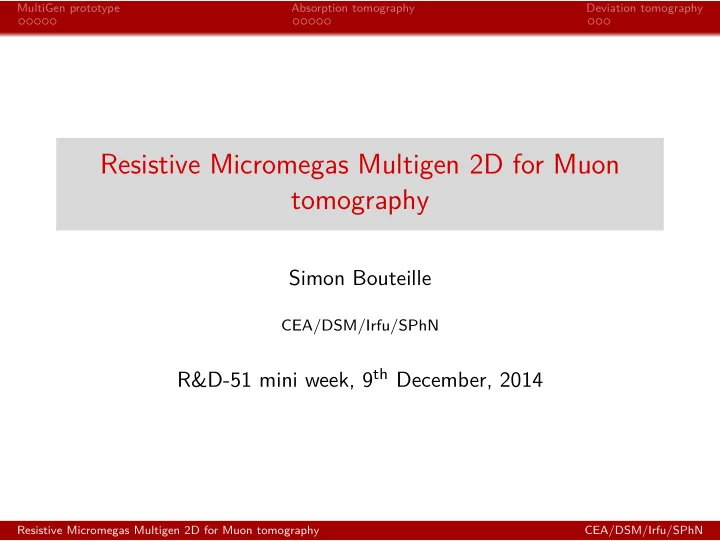

MultiGen prototype Absorption tomography Deviation tomography Resistive Micromegas Multigen 2D for Muon tomography Simon Bouteille CEA/DSM/Irfu/SPhN R&D-51 mini week, 9 th December, 2014 Resistive Micromegas Multigen 2D for Muon tomography CEA/DSM/Irfu/SPhN
MultiGen prototype Absorption tomography Deviation tomography Outline 1 MultiGen prototype Genetic multiplexing Detector overview Efficiency Capacitance studies 2 Absorption tomography Principle First results WatTo experiment 3 Deviation tomography Principle PoCA reconstruction Likelihood reconstruction Resistive Micromegas Multigen 2D for Muon tomography CEA/DSM/Irfu/SPhN
MultiGen prototype Absorption tomography Deviation tomography Genetic multiplexing • One particle : signal in multiple adjacent strips • Identify n-uplet position is enough • 1024 strips → 61 electronic channels Resistive Micromegas Multigen 2D for Muon tomography CEA/DSM/Irfu/SPhN
MultiGen prototype Absorption tomography Deviation tomography Detector overview • Dimensions : 50 × 50 cm 2 • Resistive • 2D : 2 perpendicular layer of readout strips • Multiplexed Resistive Micromegas Multigen 2D for Muon tomography CEA/DSM/Irfu/SPhN
MultiGen prototype Absorption tomography Deviation tomography Detector overview • Asymetry : • Strips parrallel with resistive strips • Strips perpendicular with resistive strips Resistive Micromegas Multigen 2D for Muon tomography CEA/DSM/Irfu/SPhN
MultiGen prototype Absorption tomography Deviation tomography Efficiency • Efficiency of the perpendicular coordinate : • At maximum gain • Before correction : 96% (amplification field : • After correction : 97% ∼ 4 · 10 6 Vm − 1 ) • Cosmic bench configuration : • 3 2D tracking detectors • 1 2D tested detector • Clustering consideration • Noise in strips perpendicular wrt. resistive strips • 1 strip without signal allowed in clustering Resistive Micromegas Multigen 2D for Muon tomography CEA/DSM/Irfu/SPhN
MultiGen prototype Absorption tomography Deviation tomography Capacitance studies • Observations : • Multiplexing increase detector capacitance • Dream electronics (CLAS12) • Average S/B with protected chips ( 220 pF decoupling capacitor) • Poor S/B with unprotected chips • Decoupling capacitor can be optimized to miximise S/B • AGET/Feminos electronics (MINOS) • Different capacitor for each chip (from 220 pF to 2 nF ) • Data taking : finished • Analysis : in progress Resistive Micromegas Multigen 2D for Muon tomography CEA/DSM/Irfu/SPhN
MultiGen prototype Absorption tomography Deviation tomography Outline 1 MultiGen prototype Genetic multiplexing Detector overview Efficiency Capacitance studies 2 Absorption tomography Principle First results WatTo experiment 3 Deviation tomography Principle PoCA reconstruction Likelihood reconstruction Resistive Micromegas Multigen 2D for Muon tomography CEA/DSM/Irfu/SPhN
MultiGen prototype Absorption tomography Deviation tomography Principle • Flux measurement • Reconstruction : • Flux difference between 2 runs • Substraction of acceptance effects • Comparison with simulations • Easy to setup • Poor resulution : ∼ 1 muon out of 100 are stopped by 10 cm of lead • High acquisition time Resistive Micromegas Multigen 2D for Muon tomography CEA/DSM/Irfu/SPhN
MultiGen prototype Absorption tomography Deviation tomography Principle • Suited to study large objects • Applications : • Volcanology • Mining exploration DIAPHANE project (IPGP, IPNL) Resistive Micromegas Multigen 2D for Muon tomography CEA/DSM/Irfu/SPhN
MultiGen prototype Absorption tomography Deviation tomography First results • Cosmicbench : • 50 × 50 cm 2 detectors • 6 1D layers • 10 cm thick lead bricks • 2 days of data (trigger rate : ∼ 6 Hz ) Resistive Micromegas Multigen 2D for Muon tomography CEA/DSM/Irfu/SPhN
MultiGen prototype Absorption tomography Deviation tomography WatTo experiment • Start date : march-april 2015 • Saclay’s watter tower tomography • 3-4 Multigen 2D telescope • 45 ◦ inclination • Why ? • Test the detector outside • Test the electronic outside • Test low consumption HV modules • Test on battery power • Test image quality versus time of acquisition Resistive Micromegas Multigen 2D for Muon tomography CEA/DSM/Irfu/SPhN
MultiGen prototype Absorption tomography Deviation tomography WatTo experiment Simulations : • Monitoring of the water height • Tank without water • Tank full of water Resistive Micromegas Multigen 2D for Muon tomography CEA/DSM/Irfu/SPhN
MultiGen prototype Absorption tomography Deviation tomography Outline 1 MultiGen prototype Genetic multiplexing Detector overview Efficiency Capacitance studies 2 Absorption tomography Principle First results WatTo experiment 3 Deviation tomography Principle PoCA reconstruction Likelihood reconstruction Resistive Micromegas Multigen 2D for Muon tomography CEA/DSM/Irfu/SPhN
MultiGen prototype Absorption tomography Deviation tomography Principle • Multiple scattering � � x measurement at both end • θ • 3D image • More information used wrt. absorption tomography • Reduce acquisition time • Need a model for reconstruction • No real data results at the moment Resistive Micromegas Multigen 2D for Muon tomography CEA/DSM/Irfu/SPhN
MultiGen prototype Absorption tomography Deviation tomography PoCA reconstruction • Simplest reconstruction • Point Of Closest Approch • middle of shortest segment between incoming trajectory and outgoing trajectory • Acceptance effect sensitive • Lot of non-used information • Density map is the PoCA distribution Resistive Micromegas Multigen 2D for Muon tomography CEA/DSM/Irfu/SPhN
MultiGen prototype Absorption tomography Deviation tomography Likelihood reconstruction • Based on maximum likelihood method • Deviation angle distributed on a gaussian • σ θ ∝ 1 /ρ • Each muon contribute to the density of every voxel he passes through • Proportionnal to the deviation ∆ x inside the voxel • Inversely proportionnal to the path length inside the voxel Resistive Micromegas Multigen 2D for Muon tomography CEA/DSM/Irfu/SPhN
Recommend
More recommend